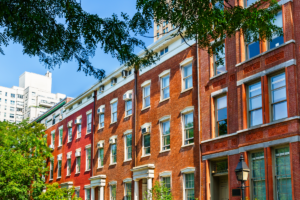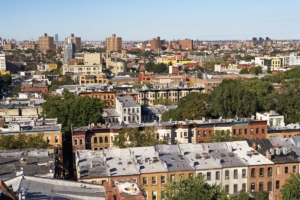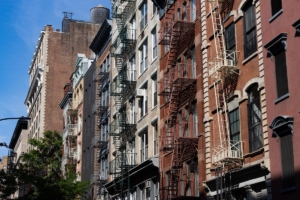
Many affluent New Yorkers are staying out of the sales market, and instead renting in some of the city’s most expensive neighborhoods.
With the New York City home sales market slowing, and plenty of uncertainty expected in the market in 2019, some New Yorkers are asking themselves: Why buy when I can rent?
Instead of chasing affordability on the sales market in Upper Manhattan or the outer boroughs, New Yorkers with sizable budgets can spend a similar amount or less renting an apartment in a more convenient location, like Dumbo or Long Island City — and many seem to be doing so.
Since the end of 2017, the Brooklyn and Queens neighborhoods with the priciest rents have seen the biggest increase in StreetEasy’s Renter Demand Index — a new statistical model from StreetEasy Research that determines renter demand by combining StreetEasy’s data on user behavior and the market.
Renter Demand Races Ahead in the Most Expensive Areas
Renter demand for the most expensive New York neighborhoods — defined as the five neighborhoods with the highest median rent in Brooklyn, Manhattan, and Queens — grew 40% faster than in the rest of the city at the end of 2018. In the same period the previous year, demand in these same pricey areas grew at a slower rate than elsewhere.
One explanation for the surge in renter demand may be that in these 15 neighborhoods, sales prices have grown three times as quickly as rents. And this rate of relative appreciation is 50% faster in these areas than elsewhere in the city. While the growth in sales prices has started to decline over the past year, and some of these neighborhoods have even seen median prices decline, their sales prices are still out-of-whack with the value proposition of many high-end rentals.
Dumbo and LIC, Priciest in Their Boroughs, Lead the Pack
At the end of 2018, rental demand in Dumbo — Brooklyn’s priciest rental neighborhood, with a median rent of $4,795 — was up 9% over the previous year, making it tied with Long Island City for the NYC neighborhood with the highest growth in demand, according to the StreetEasy Renter Demand Index
Despite Long Island City being Queens’ most expensive neighborhood to rent in, the Renter Demand Index for LIC is also up a remarkable 9% year-over-year. While it may be tempting to attribute the demand in Long Island City to Amazon’s now-abandoned plans for a major new campus, the trend was apparent long before the Amazon HQ2 announcement. (It remains to be seen how renter demand will fare in the wake of Amazon’s cancelation.)
While expensive neighborhoods in the outer boroughs are seeing rising demand from renters, Manhattan is already so expensive that its increases in demand have been smaller — with some exceptions. Battery Park City, with a lofty median rent of $4,500, nonetheless saw a 3.5% uptick in demand in 2018 over the previous year, and beat the borough average by a whole percentage point.
To Buy or To Rent? When It’s the Same Home, Renting Wins
So why are some of NYC’s most expensive neighborhoods drawing more well-heeled renters?
Even with the sales market slowing, there’s a sizable gap between the apartment one could buy at a given monthly cost, and the apartment one could rent for the same amount.
Homeownership of course brings benefits, such as building personal equity, certain tax advantages, and the ability to alter the space as one wishes. But affluent apartment seekers are finding that their dollar can fetch a lot more on NYC’s luxury rental market than on its sales market — even without considering the upfront and opportunity costs of a down payment.
Consider this luxury studio in Dumbo, which until recently was listed for sale at $799,000, but was also available for rent at $2,995 per month. To buy it, one would need the minimum 20% down payment of $159,800, after which — assuming a mortgage rate of 4.3% — their monthly costs would total about $3,800, including mortgage, common charges, and property taxes. Even forgetting the down payment, owning the condo is already $805 more expensive per month than renting it.
But what about building equity? Over the first five years of ownership, most of the buyer’s monthly outlay — an average of $2,840 — would go toward mortgage interest, taxes, and common charges, with an average contribution of only $973 toward the principal on the loan, i.e., the condo itself.
Ownership would protect the resident from rising rents. But they’d still need to contend with rising property taxes, and the unit’s low $38 monthly taxes are held down by a tax abatement that’s set to expire around 2027 [i]. After that, the full property tax of $676 per month would be due.
As a luxury rental, this unit found a tenant in 32 days. On the sales market — listed as an investment opportunity with a tenant in place through April 2020 — the unit sat for 110 days. Finally, it was delisted without selling. Clearly the market found one of these value propositions more enticing.
In 2019, Renting in NYC Evades Financial Risk
With slowing price appreciation around New York City, buyers are taking a risk by assuming their new home will rise in value enough to produce a good return on their investment.
Unless there are dramatic changes in the relative rates of rent and home price appreciation over the next few years, even the relatively low level of mortgage rates is not enough to make buying financially attractive compared to renting. Using current market conditions, and with optimistic assumptions, our calculations estimate that it would take eight years for a buyer of the Dumbo condo to break even compared to the cost of renting it.
This year will bring even more new high-end inventory to the rental market, giving renters with sizable budgets even greater selection and negotiating leverage. More than 18,000 rentals have already hit the market in our 15 high-demand neighborhoods [ii] in the first four months of the year alone — 11% more than in the same period last year. We expect rising rental demand, and the favorability of renting over buying, to continue until sellers adjust their expectations and bring sales prices back into closer competition with the rental market.
How We Did It
The StreetEasy Renter Demand Index compares apartments that have been rented on StreetEasy more than once, looking at how prices have changed over time and how quickly units were taken off the market after being listed. Using StreetEasy data and a machine-learning model, the index predicts how quickly an apartment will be rented based on how users are interacting with the listing on StreetEasy, as well as broader data on the entire NYC rental market. We then compare that to what actually happened. If, for example, an apartment fetched a higher rent than it did the previous year, and sat on the market for fewer days than expected, we can reasonably infer that demand increased for that particular apartment. Apartment rental trends also vary throughout the year, and even within a given month, so we adjusted the StreetEasy Renter Demand Index for seasonality.
[i] Assumes a 15-year abatement (as noted on the tax bill) expires 15 years after the original purchase in 2012.
[ii] Defined as the top 5 most expensive neighborhoods by median asking rent in Manhattan, Brooklyn and Queens.
—
Inspired to find your next place in New York? Whether you’re looking to rent or to buy, search NYC apartments on StreetEasy.








